The smell of Korean street food hits you moment you escape the high rises and wander down to the markets, side streets, subway stations, and universities. Korea’s street vendor culture dates back over 600 years to the Joseon dynasty (1392-1910) where cooked food was sold at neighbourhood markets for hungry locals. Today, the street food scene in Korea is colorful, vibrant and includes not just the region’s traditional, tasty meals, but weird and wild Western-inspired dishes, too.
Myeongdong, Jongno, Dongdaemun, and the historical Gwangjang Market are some of the best spots to find fresh, local food on the street, especially when shopping in Seoul at night. eIn the port city of Busan, BIFF Square is a bustling street food hub that’s a must-hit. And, unlike other street food hubs around the world, Korea favors hand-held treats that you can eat standing up or while walking (rather than sit down meals like you might find in Singapore or Bangkok).
So, arrive with an empty belly, keep your eye out for the brightly coloured tents (pochangmachas), and get ready to enjoy all 10 of these traditional, casual, and absolutely drool-worthy Korean street food meals:
Korean Street Food: Tteokbokki (stir-fried rice cakes)
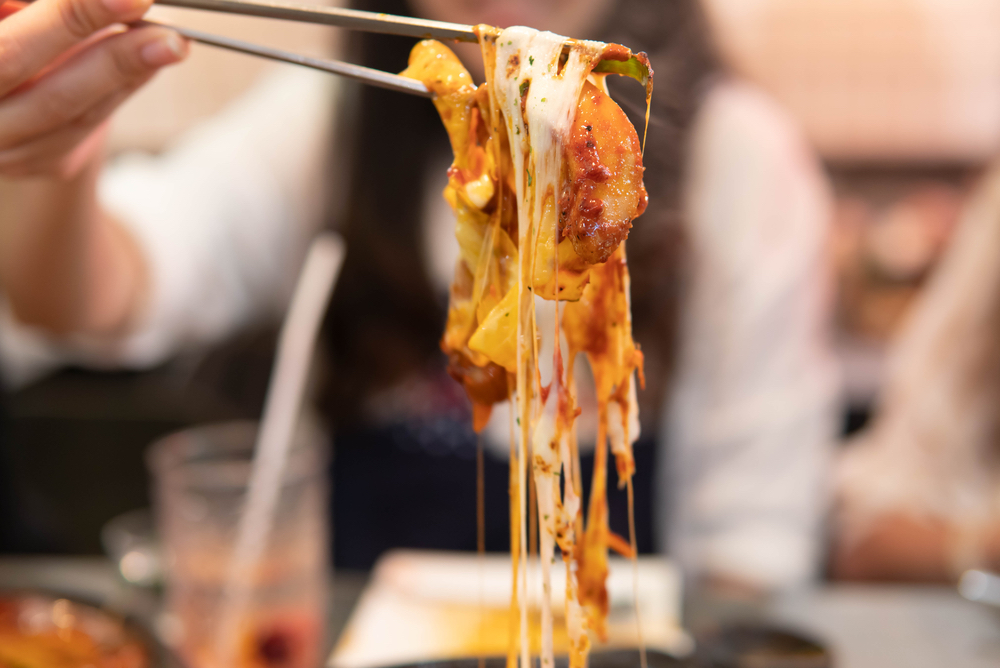
Spicy, chewy, and utterly wholesome. Typically eaten with a toothpick or chopsticks, tteokbokki is made from garaetteok, or glutinous rice cakes (which resemble packing peanuts) and then stir-fried in gochujang (red chilli pepper paste) sauce. Find a serving with cheese on top to be extra indulgent, or snag one with egg or fish cakes added atop for some extra protein and taste.
Where to try: Honestly, you’ll find delicious tteokbokki in pretty much any street food market across Korea, but our favorite places to try it are Tongin Market, where you can get a special fried variety, or go wild and chow down at at Sindang-dong Tteotbokki Town.
Korean Street Food: Bungeoppang (fish-shaped pancakes)
Translating literally to ‘carp bread,’ you’ll notice these fish-shaped treats in neat lines on a cart — that is, if you don’t smell them first. Similar to the Japanese taiyaki, bungeoppang taste like a cross between a sponge and pancake. You’ll find these hot and waiting, or you’ll spot them being freshly poured into their carp iron moulds, almost ready for tasting. Popularised after the Japanese occupation, a traditional filling is red bean paste, but today you’ll find anything from Nutella to custard to sweet potato lurking inside. Ask the vendors for a scoop of ice cream on the side to be extra indulgent.
Where to try: Myeongdong Shopping Street is the best place to go for this tasty treat with several Bungeoppang vendors along the main street food strip.
Korean Street Food: Gyeran-ppang (steamy hot “egg bread”)
Particularly popular near the universities, these fluffy oblong shaped ‘egg breads’ sit on top of a giant steamer that can be spotted a mile off due to the plumes of mist and smoke emerging from the tents. A steamy mixture of batter and a whole egg on top, the sweet vanilla and slightly salty egg taste work in absolute harmony; it’s almost impossible to pass by this smell of sweet, fresh bread. One of the cheapest street foods on offer, they’re filling, warm, and entirely addictive.
Where to try: Since gyeran-ppangit is popular student street food, some of the best vendors can be found in Hongdae and the surrounding university areas. Head directly to Hongdae Walking Street and nibble one while you watch the street performers.
Korean Street Food: Kimbap (full meal sushi rolls)
The classic kimbap (often spelt gimbap) can be found everywhere from packed lunches to convenience stores. And did we mention that it’s a must-try street food staple? Similar to sushi rolls but slightly sweeter and densely packed, kimbap really is a full meal wrapped up in tight seaweed. If you’re in Korea on a budget, eating lots of kimbap is the easiest (and healthiest) way to keep costs down. There are an abundance of flavors to choose from, but classics include tuna, spam, crab, and the delicious spicy kimchi that’ll have you coming back for more. Dip in soy sauce and enjoy, or you can pick up triangle kimbap or samgak-kimbap (similar to Japanese onigiri), which are perfect for eating on the go.
Where to try: Gangnam Station Underground Shopping is infamous for grabbing the cheapest and cutest Korean fashion and delicious kimbap! There are a few vendors with tables to sit at if you want to hang around and people watch.
Korean Street Food: Pajeon (savory pan-fried pancakes)
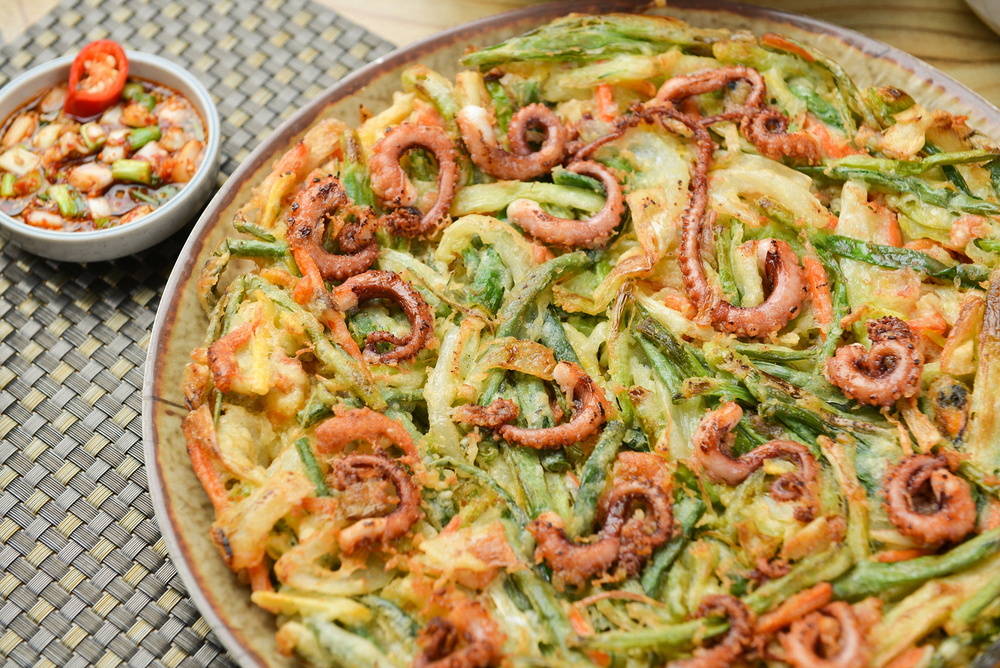
One of the best things about traveling around East Asia is discovering foods that remind you of home, but with a subtle twist. In Korea, that food is savory pancakes — and prepare to find them everywhere. The Korean pajeon recently spiked in popularity thanks to the West’s obsession with kimchi pancakes, and they can be easily found wherever you’ll spot street food (or you can visit Pajeon Alley, an entire street dedicated to these meet, cheese and veggie-filled pancakes in Seoul). They’re crispy, light, and are typically filled with scallions, squid, beef, cheese, or kimchi. The Korean name will differ slightly depending on the dominant ingredient. Try as many as you can since they’re all delicious, cheap, and filling.
Where to try: Undoubtedly, the best place to try Pajeon is in Pajeon Alley, but they also offer excellent Pajeon at Tongin Market.
Korean Street Food: Eomuk (squiggle-shaped fish cakes)
Eomuk is a warm and filling street food that originated in Japan, but became popular in Busan, where you can still find the most delicious fish cakes in the country today. Served on a skewer and soaking in broth, these chewy slices of fish (usually presented in a wiggle shape) could easily be mistaken for tofu. A full seafood stick and a cup of soup will go for a dollar or less, is bursting with flavour, and is relatively healthy, making it a popular choice. Pro tip: pair your eomuk with tteokbokki for the perfect street food meal.
Where to try: Head to Gwangjang Market for the tastiest and largest selection, or hop over to the Bupyeong Kkangtong Market in Busan if you’re headed South.
Korean Street Food: Mandu (delicious steamed or fried dumplings)
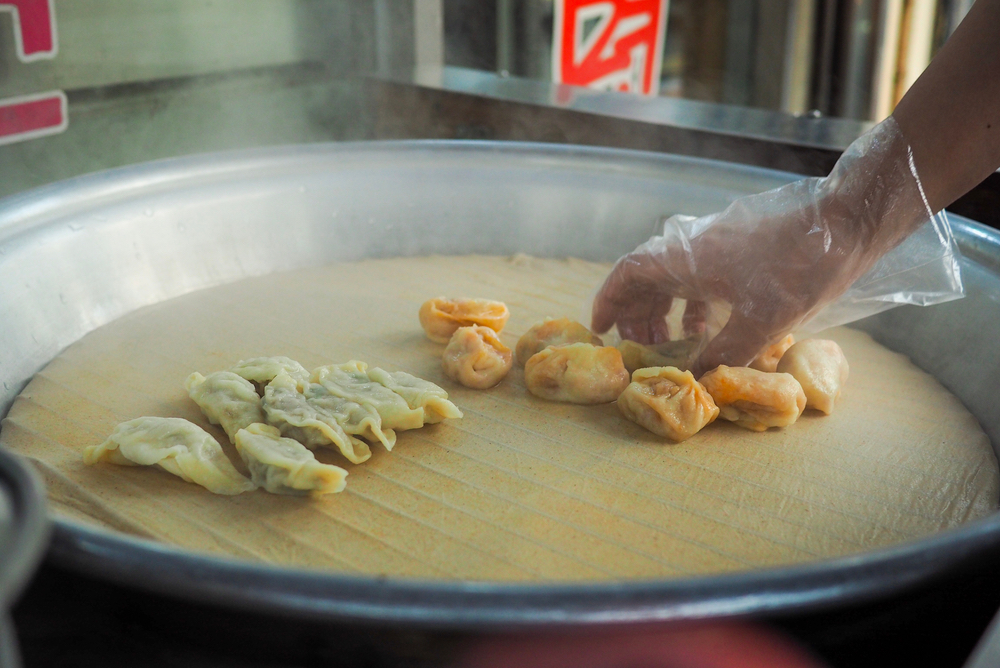
Who isn’t a fan of dumplings? This longstanding traditional food, once part of the royal cuisine, is now an everyday staple in Korea. Korean mandu are as tasty as you’re imagining: they come fried or steamed and are normally filled with cabbage and pork, although the kimchi varieties are worth seeking out. Cheap and entirely filling, grab a tray of six and you’re good to go for the day.
Where to try: You’ll be able to find mandu at every street food market and most stations, but a favourite spot for some excellent Mandu is Dongdaemun Night Market.
Korean Street Food: Dak-Kkochi (flavorful fried chicken)
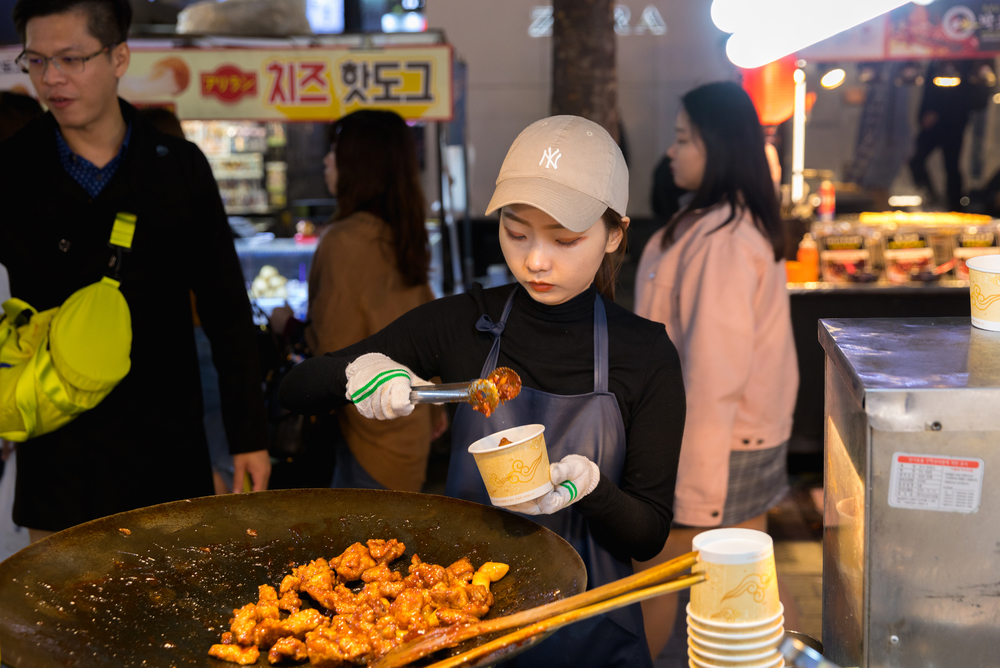
Korean fried chicken is an art form, and you won’t leave the country without hearing chimaek (the past time of enjoying chicken and beer) being suggested at least once. Name a flavour you could possibly apply to chicken and it’s available in Korea. The street-food version is dak-kkochi, fried chicken and scallions on skewers grilled over coal before being smothered in a gochujang sweet and sour sauce. You can also find other forms of kkochi or skewered food including sausages and seafood.
Where to try: The best places for some tasty skewers are undoubtedly Myeongdong Shopping Street, BIFF Square in Busan, and Namdaemun Market.
Korean Street Food: Hotteok (sweet cinnamon-filled pancakes)
Another sweet treat that’s ideal to warm you up during Korea’s harsh winters. Easily spotted in little orange tents, they’re usually found in the street food markets and dotted around downtown. Although you can buy these frozen in stores or ready-made in bakeries, eat hotteok straight out of the pan for the best experience. A firm favourite with locals and tourists, they’re essentially a cross between a crispy pancake and doughnut: chewy on the inside and filled with syrup, cinnamon, and nuts on the inside. At less than a dollar, it’s fair to say it’s easy to enjoy a hotteok…or three.
Where to try: Some of the best hotteok in the country can be found just outside the station in Namdaemun Market
Korean Street Food: Beondegi (steamed silkworm pupae)
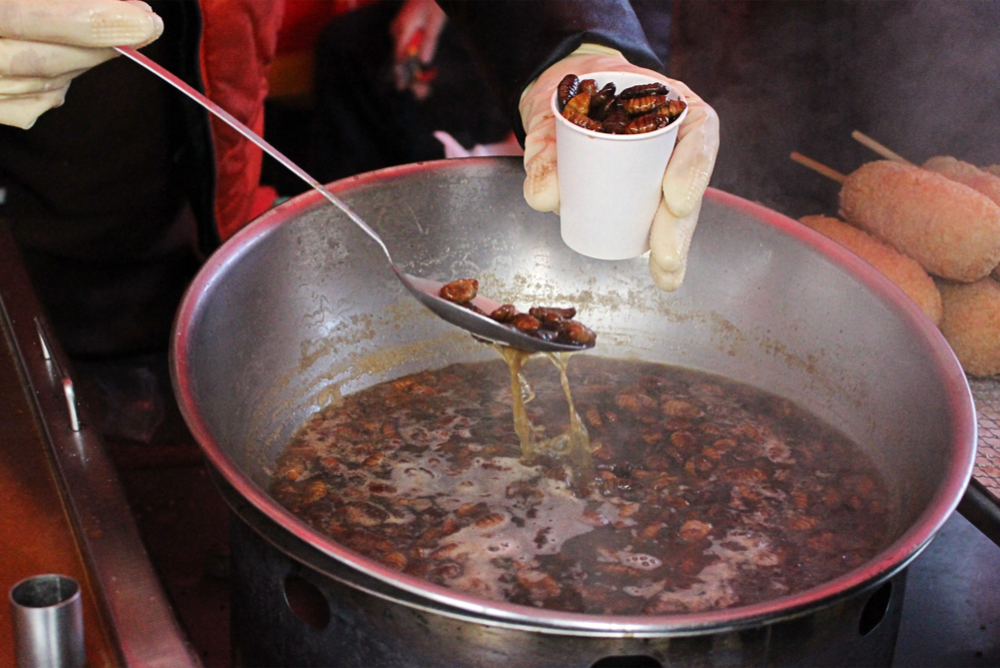
Okay, so now that we’ve got you drooling, we’re going to hit you with a dish that might be a bit hard to swallow (literally). Say hello to one of the least popular street foods in Korea: beondegi. Strange and unique to this region, Beondegi, or silkworm pupa, is a cup filled with boiled or steamed worm pupae. Served in paper cups with toothpick skewers, beondegi is perfect for folks who are looking to try something completely traditional and unique (heads up, most locals don’t even like munching on these steamed worm babies). On the plus side, beondegi is incredibly cheap: one cup full is usually just over a dollar. They’re juicy, crunchy, and have a nutty and somewhat fishy flavour.
Where to try: Brave enough to give it a go? Then head to Namdaemun Market or Gwangjang Market for some tasty critters.